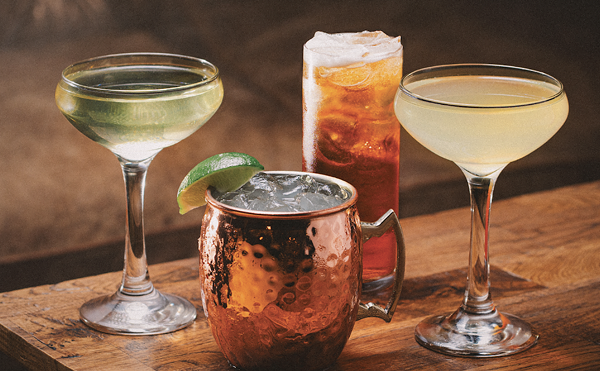|
The Cincinnati Wine School might be the city's only institution where students enjoy studying. Though not listed among Princeton Review's "top party schools," it's only in these hallowed halls where students eagerly swirl, sniff and sip their way through an entire curriculum.
It should be noted, though, that there are no actual "hallowed halls." In fact, the relatively new school is the brainchild of Paul Ortiz, former sommelier at Cincinnati's much-praised Boca.
Paul wasn't born into a family of oenophiles ("wine lovers"); his earliest wine memories are limited to bottles of Lancer's blush in the refrigerator. Years later, however, his mother mentioned that her father had made his own wine for personal consumption — "and to share with friends," Ortiz adds.
A quick review of Ortiz's resume shows that he likely inherited his grandfather's hospitable nature. He worked, on and off, in the restaurant business for much of his adult life — even while in school (he earned a master's degree in education from Xavier University) and, later, while working as a teacher and counselor. As a server at a Mount Adams restaurant, Ortiz eagerly took responsibility for the beverage selections. This experience turned a vague curiosity about wine into a full-blown passion.
"At the time, a local wine shop owner told me the only way to learn about wine is to read and taste," he says.
So, to further educate his palate, he continued tasting and discussing wines through a part-time job at the Wine Merchant (where many Wine School classes are now held). Ortiz then became a "fine wine specialist" with a big distributor, enabling him to drink his way throughout Europe and California. In time, he met chef David Falk, who asked him to help build Boca's ambitious wine program.
The idea for a "Cincinnati Wine School" came out of the blue and blossomed quickly. Ortiz was discussing wine selections with a family one evening at Boca.
"Their son was home from culinary school," he recalls, "and he asked me where he could learn about wine."
Ortiz recommended the Chicago Wine School. Another member of the party asked where she could pursue wine education locally.
"At that moment, the idea for the Cincinnati Wine School was born," he says. "There are many wine tastings in Cincinnati — but education is almost always a secondary goal."
When local wine shops sponsor tastings, they primarily want to move product. Ortiz's "eureka moment" came when he realized that the city needed a venue where one could get an unbiased wine education.
"People urged me to open my own wine shop," he says. "But I want this to be about education, not about sales."
Within two months, the first tasting classes were held. Not long after, he made the difficult decision to leave Boca to focus on this new venture.
"I'm an entrepreneurial person," he explains. "I've always wanted to build something of my own."
The Cincinnati Wine School is an almost alchemical joining of Ortiz's disparate skills and interests — a love of wine, a knack for entertaining, and a passion for teaching. In fact, through his role as sommelier, he was already educating consumers. The Wine School simply lets him focus on the basics for those just developing an interest — and to provide more information to those who wish to dig deeper in a particular area.
Ortiz's "intro" course includes three sessions. The first covers the basics: What wine is, how it's made and basic terms (e.g., balance, structure, tannin, palate, aroma, etc.). The second covers major white varietals (grape types): Chardonnay, Sauvignon Blanc, Riesling and Pinot Gris/Grigio. The third covers major reds: Cabernet Sauvignon, Pinot Noir, Sangiovese and Syrah.
At a recent class, the participants had varying levels of wine knowledge. One couple had just returned from France, where they had been stymied by the variety and price ranges they encountered at a Parisian market.
"Is there a big difference in quality," they wanted to know, "between a $5 bottle and one costing $15?"
Another couple often drinks wine with dinner, but wanted to start branching out. And a Wine Merchant staffer attended as well, hoping to further hone his palate.
Ortiz teaches that there's a useful distinction between Old World (European) and New World (everywhere else) style wines. The advantage to Ortiz's class is that you actually taste what these terms mean while discussing your impressions (smell, taste, mouth feel) with others in a non-judgmental setting. "New World" wines are shown to be fruitier, lower in acid and higher in alcohol than their "Old World" counterparts, which tend to be leaner, earthier, lower in alcohol and higher in acid.
After tasting 24 wines over three sessions, participants gain a firm grasp on the wine styles they prefer and are able to articulate those preferences when seeking advice in a shop or a restaurant.
For now, Wine School classes are offered at local wine shops, and several different series will be available in March, including the three-part "Intro to Wine" at City Cellars and a series on Italian wines at the Wine Merchant. Someday, Ortiz intends to find a physical home for his school.
"I'd like to have a small kitchen and serve tapas," he says. "So I'd really be able to focus on food and wine pairings. But I'm not ready to make that leap yet. I'm in a mode to see how it all evolves."
For more information on Paul Ortiz's Cincinnati Wine School, go to www.cincinnatiwineschool.com.





